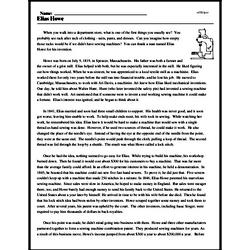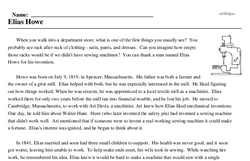Elias Howe
Elias Howe
Reading Comprehension for July 9
When you walk into a department store, what is one of the first things you usually see? You probably see rack after rack of clothing - suits, pants, and dresses. Can you imagine how empty those racks would be if we didn't have sewing machines? You can thank a man named Elias Howe for his invention.
Howe was born on July 9, 1819, in Spencer, Massachusetts. His father was both a farmer and the owner of a grist mill. Elias helped with both, but he was especially interested in the mill. He liked figuring out how things worked. When he was sixteen, he was apprenticed to a local textile mill as a machinist. Elias worked there for only two years before the mill ran into financial trouble, and he lost his job. He moved to Cambridge, Massachusetts, to work with Ari Davis, a machinist. Ari knew how Elias liked mechanical inventions. One day, he told him about Walter Hunt. Hunt (who later invented the safety pin) had invented a sewing machine that didn't work well. Ari mentioned that if someone were to invent a real working sewing machine it could make a fortune. Elias's interest was ignited, and he began to think about it.
In 1841, Elias married and soon had three small children to support. His health was never good, and it soon got worse, leaving him unable to work. To help make ends meet, his wife took in sewing. While watching her work, he remembered his idea. Elias knew it would be hard to make a machine that would sew with a single thread as hand sewing was done. However, if he used two sources of thread, he could make it work. He also changed the place of the needle's eye. Instead of having the eye at the opposite end of the needle from the point, they were at the same end. The needle's point would push through the cloth, pulling a loop of thread. The second thread was fed through the loop by a shuttle. The result was what Howe called a lock stitch.




